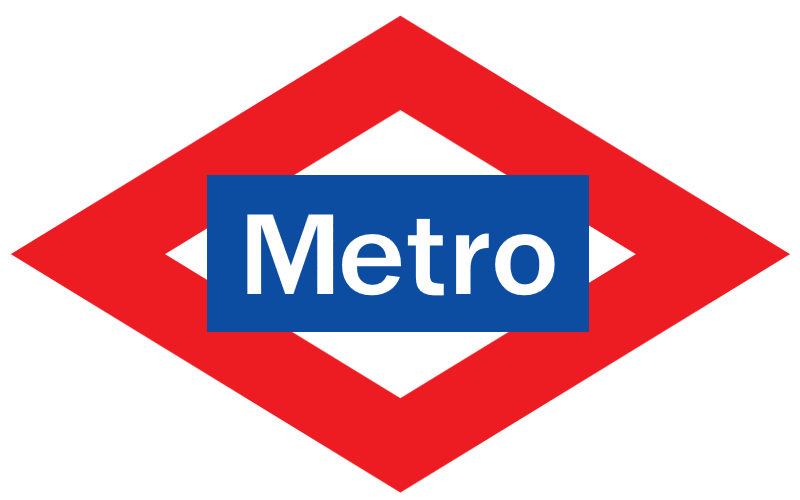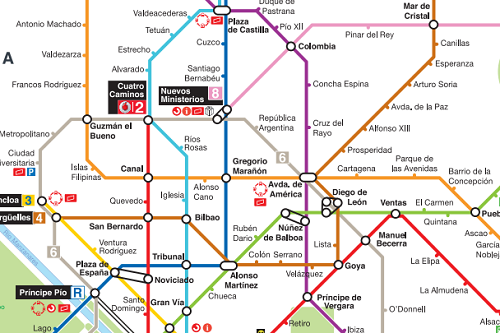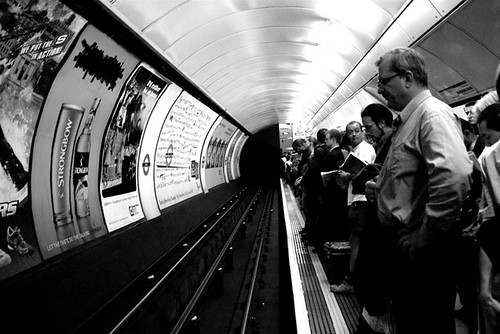
Image Source: Wikimedia Commons
After spending 4 days in sunny Madrid last week, I think got a good feel for the city (friendly people, great food and cheap beer) along with its metro system (Metro de Madrid). While it’s no secret that I’m a huge fan of the Tube, I think there are (at least) 5 ways Madrid’s Metro clearly beats the London Underground.
1. It’s Cheaper
While both have zone systems, pretty much anyway you cut it, Madrid is much cheaper than London. In Madrid, the basic cash fare for the Metro is €1.50 (£1.21), whereas in London, it’s £2.20 (€2.70) for a non-peak zone 1-2 journey paid with Oyster or a whopping £4.70 (€5.80) if the fare is paid in cash.
2. It Has More Lines

London boasts an impressive 11 underground lines (well 10 if we exclude the two-stop Waterloo & City line). However, Madrid has it’s own two-stop line, along with 12 others. This means that it beats London by 2 whole lines.
3. It Has More Stations
London Underground has 270 stations, which is pretty good until you learn that Madrid has 300. Moreover, until the recent financial crisis, Madrid was adding stations at rate that hasn’t been seen in London for over 60 years. According to Wikipedia (would be great if someone had a better source), Madrid’s Metro added 90 km (56 mi) of track and 80 new stations to the network between 2003 and 2007.
To put this in perspective, it’s roughly equivalent to the length and number of stations found on London’s entire Overground network.
4. It Has Far More Stations Per Capita
What’s even more impressive is that it has far more stations per capita than London. Madrid itself only has a population of 3.3 million compared to the roughly 8.2 million people who live in Greater London.
This means that Madrid has one station per 11,000 people, whereas London has 1 station per 30,370 people.
5. It’s Less Crowded
Roughly 1.2 billion annual trips were taken on London Underground in 2013 compared to just 558 million taken on Madrid’s Metro. This means that, on average, only half the number of people use the Madrid Metro each day compared to the Underground. Great if you want to get a seat!
So while London still has an older network with significantly more miles of track, Madrid’s Metro stacks up pretty well on most head-to-head comparisons.
A Few Other Random Observations
- For some reason the Madrid Metro is left-hand running, which is odd as Spaniards drive on the right. This may be due to the fact that residents of Madrid used to drive on the left until 1924.
- The Madrid Metro turns 95 this year, which sounds old until you realise that the Underground is 56 years older.
- The Madrid Metro doesn’t currently have a direct line from the City Centre to the main airport. Almost all passengers have to change to another line. While only the Piccadilly line goes to Heathrow, it does pass through central London.
- I didn’t see any adverts in the trains themselves. Although you do get ads in the stations and on platforms…
- And, most surprisingly, Line 2 of the Metro along with Sol station are both sponsored by Vodafone. And don’t think this can’t happen to London as it’s already being talked about.
These are just a few of the things I noticed in my rather limited interaction with Madrid’s Metro. If you know of anything I’ve missed, other differences and/or interesting features, please tell me about them in the comment section below:



I had heard that the metro runs on the left as it was designed by Brit, therefore using the same system as back home. Not sure of the facts tho.
That thought did occur to me as well, but can’t seem to find a source for it.
The reason behind Metro de Madrid being left-hand running is exactly what you mentioned in the article. After we changed to right-hand driving in the surface, it was too expensive to change the Metro, so it remained as it is.
Light rail Metro is right-hand running (which is understandable as drivers usually look first to the left in a crossroad).
I want to point out some inaccuracies of your article: Madrid city have 3.3 million inhabitants, but Metro de Madrid also covers other 11 cities of Madrid province with a total population of 1.4 million.
Sometimes there are specific marketing campaign in the trains, although they are not permanent.
We didn’t think the sponsoring of a Metro line can be done, and there you have it… (with a lot of criticism from Metro fans).
Regards, you have a great blog!!!
Thank you very much for the additional information, very interesting.
I should just point out that the population numbers for London are also a bit misleading as the Tube also serves areas outside of Greater London (e.g. Epping, Watford, Amersham, Chesham, etc.) so making any sort of comparison is fraught with difficulty.
Glad you enjoy the blog!
Greater London is 8.2 million people. Great Madrid is around 5 millions.
The Madrid metro runs a lot less frequent than the Tube and as such is quite a slow way of getting around, it has significantly smaller narrower trains and doesn’t cover as many destinations as the Underground.
The trains of Madrids metro run about every 4 minutes peak time and every 7 to 11 minutes off peak.
It runs to virtually every part of the city centre.
Ive used both and can confidently say Madrids metro is far better .
Madrids metro though can also get quite packed.
Even though its population is not as big as Londons (Madrids metro area has about 6.5 million people) the people are alot more outdoorsy than Londoners.
Two more advantages of Madrid Metro over London Tube:
Since tunneling used to be costly in the past, London tunnels are very narrow and so are trains. Metro was built much later and this allowed the trains to be much wider so as to enjoy vertical side walls on which you can lean, while claustrophobic round shaped trains are common in the Tube.
Madrid Metro’s organisation is simpler and so more first time visitor friendly. For instance the line diverting you can find in London’s St. Pancras, which can lead you to take the wrong train, something that can never happen in Madrid.
Regards